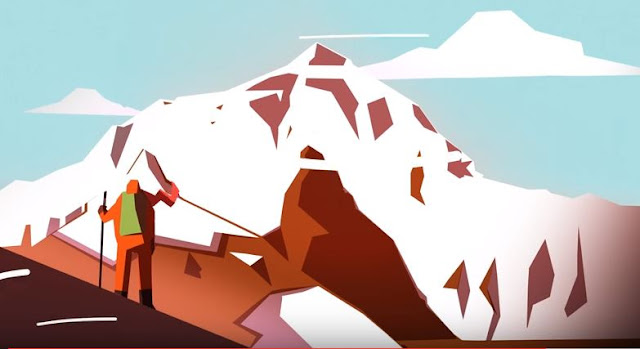Why is Mount Everest so tall?
Every spring,
hundreds of adventure-seekers dream of climbing Qomolangma, also known as Mount Everest. At base camp, they hunker down for months waiting for the chance to scale the mountain's lofty, lethal peak. But why do people risk life and limb to climb Everest? Is it the challenge?
The view? The chance to touch the sky? For many, the draw is Everest's status as the highest mountain on Earth. There's an important distinction to make here. Mauna Kea is actually the tallest from base to summit, but at 8850 meters above sea level,
Everest has the highest altitude on the planet. To understand how this towering formation was born, we have to peer deep into our planet's crust, where continental plates collide. The Earth's surface is like an armadillo's armor. Pieces of crust constantly move over,
under, and around each other. For such huge continental plates, the motion is relatively quick. They move two to four centimeters per year, about as fast as fingernails grow. When two plates collide,
one pushes into or underneath the other, buckling at the margins, and causing what's known as uplift to accomodate the extra crust. That's how Everest came about. 50 million years ago, the Earth's Indian Plate drifted north, bumped into the bigger Eurasian Plate, and the crust crumpled, creating huge uplift.
Mountain Everest lies at the heart of this action, on the edge of the Indian-Eurasian collision zone. But mountains are shaped by forces other than uplift. As the land is pushed up, air masses are forced to rise as well. Rising air cools, causing any water vapor within it to condense and form rain or snow.
As that falls, it wears down the landscape, dissolving rocks or breaking them down in a process known as weathering. Water moving downhill carries the weathered material and erodes the landscape, carving out deep valleys and jagged peaks. This balance between uplift and erosion gives a mountain its shape.
But compare the celestial peaks of the Himalayas to the comforting hills of Appalachia. Clearly, all mountains are not alike. That's because time comes into the equation, too. When continental plates first collide, uplift happens fast. The peaks grow tall with steep slopes.
Over time, however, gravity and water wear them down. Eventually, erosion overtakes uplift, wearing down peaks faster than they're pushed up. A third factor shapes mountains: climate. In subzero temperatures, some snowfall doesn't completely melt away, instead slowly compacting until it becomes ice.
That forms the snowline, which occurs at different heights around the planet depending on climate. At the freezing poles, the snowline is at sea level. Near the equator, you have to climb five kilometers before it gets cold enough for ice to form. Gathered ice starts flowing under its own immense weight
forming a slow-moving frozen river known as a glacier, which grinds the rocks below. The steeper the mountains, the faster ice flows, and the quicker it carves the underlying rock. Glaciers can erode landscapes swifter than rain and rivers. Where glaciers cling to mountain peaks, they sand them down so fast,
they lop the tops off like giant snowy buzzsaws. So then, how did the icy Mount Everest come to be so tall? The cataclysmic continental clash from which it arose made it huge to begin with. Secondly, the mountain lies near the tropics, so the snowline is high, and the glaciers relatively small,
barely big enough to widdle it down. The mountain exists in a perfect storm of conditions that maintain its impressive stature. But that won't always be the case. We live in a changing world where the continental plates, Earth's climate,
and the planet's erosive power might one day conspire to cut Mount Everest down to size. For now, at least, it remains legendary in the minds of hikers, adventurers, and dreamers alike.
See Video Below:
hundreds of adventure-seekers dream of climbing Qomolangma, also known as Mount Everest. At base camp, they hunker down for months waiting for the chance to scale the mountain's lofty, lethal peak. But why do people risk life and limb to climb Everest? Is it the challenge?
 |
| Why is Mount Everest so tall? - Michele Koppes |
The view? The chance to touch the sky? For many, the draw is Everest's status as the highest mountain on Earth. There's an important distinction to make here. Mauna Kea is actually the tallest from base to summit, but at 8850 meters above sea level,
Everest has the highest altitude on the planet. To understand how this towering formation was born, we have to peer deep into our planet's crust, where continental plates collide. The Earth's surface is like an armadillo's armor. Pieces of crust constantly move over,
under, and around each other. For such huge continental plates, the motion is relatively quick. They move two to four centimeters per year, about as fast as fingernails grow. When two plates collide,
one pushes into or underneath the other, buckling at the margins, and causing what's known as uplift to accomodate the extra crust. That's how Everest came about. 50 million years ago, the Earth's Indian Plate drifted north, bumped into the bigger Eurasian Plate, and the crust crumpled, creating huge uplift.
 |
| Why is Mount Everest so tall? - Michele Koppes |
Mountain Everest lies at the heart of this action, on the edge of the Indian-Eurasian collision zone. But mountains are shaped by forces other than uplift. As the land is pushed up, air masses are forced to rise as well. Rising air cools, causing any water vapor within it to condense and form rain or snow.
As that falls, it wears down the landscape, dissolving rocks or breaking them down in a process known as weathering. Water moving downhill carries the weathered material and erodes the landscape, carving out deep valleys and jagged peaks. This balance between uplift and erosion gives a mountain its shape.
But compare the celestial peaks of the Himalayas to the comforting hills of Appalachia. Clearly, all mountains are not alike. That's because time comes into the equation, too. When continental plates first collide, uplift happens fast. The peaks grow tall with steep slopes.
Over time, however, gravity and water wear them down. Eventually, erosion overtakes uplift, wearing down peaks faster than they're pushed up. A third factor shapes mountains: climate. In subzero temperatures, some snowfall doesn't completely melt away, instead slowly compacting until it becomes ice.
That forms the snowline, which occurs at different heights around the planet depending on climate. At the freezing poles, the snowline is at sea level. Near the equator, you have to climb five kilometers before it gets cold enough for ice to form. Gathered ice starts flowing under its own immense weight
forming a slow-moving frozen river known as a glacier, which grinds the rocks below. The steeper the mountains, the faster ice flows, and the quicker it carves the underlying rock. Glaciers can erode landscapes swifter than rain and rivers. Where glaciers cling to mountain peaks, they sand them down so fast,
they lop the tops off like giant snowy buzzsaws. So then, how did the icy Mount Everest come to be so tall? The cataclysmic continental clash from which it arose made it huge to begin with. Secondly, the mountain lies near the tropics, so the snowline is high, and the glaciers relatively small,
barely big enough to widdle it down. The mountain exists in a perfect storm of conditions that maintain its impressive stature. But that won't always be the case. We live in a changing world where the continental plates, Earth's climate,
and the planet's erosive power might one day conspire to cut Mount Everest down to size. For now, at least, it remains legendary in the minds of hikers, adventurers, and dreamers alike.
See Video Below:
Why is Mount Everest so tall?
 Reviewed by Unknown
on
7:17 AM
Rating:
Reviewed by Unknown
on
7:17 AM
Rating:
 Reviewed by Unknown
on
7:17 AM
Rating:
Reviewed by Unknown
on
7:17 AM
Rating:











No comments: